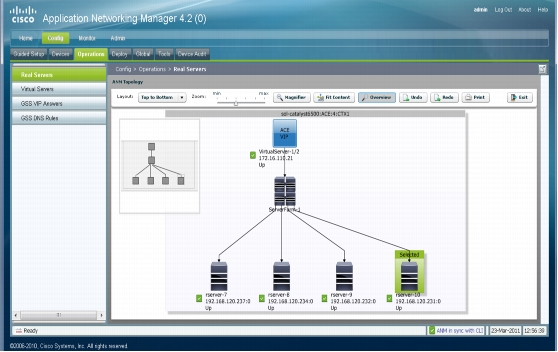PB572614
• Cisco ANM Increases productivity by helping you delegate tasks beyond networking and operations staff. For example, it enables services deployment by even Tier 1 operators while providing full configuration capabilities for advanced engineers.
• Cisco ANM reduces risk of service outages due to syntax or processing errors.
• Cisco ANM reduces configuration sprawl by helping you standardize device configuration.
• Overall, Cisco ANM reduces total cost of ownership (TCO) by providing a single interface for provisioning, operations, maintenance, and monitoring across multiple systems

New Features
• Dynamic workload scaling: Cisco ANM 4.2 allows you to configure dynamic workload scaling (DWS), which is a Cisco ACE feature that permits on-demand access to remote resources, such as VMware Virtual Machines that you own or lease from an Internet service provider (or cloud service provider). This feature uses Cisco Nexus® 7000 Series Switches with Cisco Overlay Transport Virtualization (OTV), which is a Cisco Data Center Interconnect (DCI) technology used to create a Layer 2 link over an existing IP network between geographically distributed data centers. Cisco ANM 4.2 supports the DWS feature for Cisco ACE Software Release A4(2.0) for both the Cisco ACE Module and Cisco ACE appliances.
• Cisco ANM backups for use with the Cisco ANM server and Cisco ANM virtual appliance: Cisco ANM virtual appliances can now create or use Cisco ANM backups for restore and upgrade operations. The Cisco ANM backups created on the virtual appliance and the Cisco ANM server software can be used interchangeably across both installations. For instance, a Cisco ANM backup on a Cisco ANM server with a compatible version can be restored or upgraded on a Cisco ANM virtual appliance, and a Cisco ANM virtual appliance can be restored on a Cisco ANM server.
• Remote authorization of Cisco ANM users: Cisco ANM 4.2 supports remote authorization through TACACS+ server. When Cisco ANM authorizes a remote user, it sends a request to the TACACS+ server, which returns the role and domain names of the requested user. The definitions of roles and domains are stored locally on Cisco ANM. Combining this feature with the existing remote authentication feature allows you to set up Cisco ANM so that all Cisco ANM user authentication and authorization is performed remotely using a TACACS+ server. This approach eliminates the need to create users on Cisco ANM for those authenticated and authorized through TACACS+; users need only be created on the TACACS+ server.
• Source email address for email alerts: Cisco ANM 4.2 provides an option to set the Mail From email address when specifying the Simple Mail Transfer Protocol (SMTP) server to use for outgoing email alerts (Monitor > Settings > SMTP Configuration). By default, the Mail From address is set to anm@hostname. You can request email alerts when configuring a threshold group (Monitor > Alarm Notifications > Threshold Groups) or when enabling the Historical Data Export feature (Monitor > Settings > Historical Data Export). With this feature, your SMTP server can check the source of email alerts by using the Mail From email address.
• Health monitor probe for redirect real servers and server farms: Cisco ANM 4.2 supports the Cisco ACE capability to probe the destination of a redirect real server, which is accomplished by associating a health probe with a redirect server farm or a redirect real server.
• Operations enhancement: Cisco ANM 4.2 provides the following operations enhancements:
– Capability to specify the customized username and password prompts to use when importing a Cisco Catalyst® 6500 Series Switch or Cisco 7600 Series Router to Cisco ANM; for more information, see the user guide for Cisco ANM 4.2
– Improved on-demand polling response time for real and virtual servers from the Operations and Monitoring windows; Cisco ANM 4.2 also reduces the activate and suspend operation waiting times for real and virtual servers from the Operations window
Product Availability
• Cisco ANM Server for Red Hat Enterprise Linux: Cisco ANM servers can be run on supported 64- and 32-bit versions of Red Hat Enterprise Linux.
• Cisco ANM Virtual Appliance for VMware: The virtual appliance is run as a virtual machine in a VMware 4.0 or 4.1 environments. There is no change to the Cisco ANM user's web interface, nor does the use of this appliance affect the way that Cisco ANM manages network devices. When deployed, this appliance is nearly identical to Cisco ANM run on a standalone Linux server; it is a complete computing system, including the application and operating system and an interface similar to the Cisco IOS® Software interface for administration functions such as backing up and restoring the system and configuring Simple Network Management Protocol (SNMP) properties.
The Cisco ANM virtual appliance is interchangeable with the Cisco ANM server. This interchangeability makes the appliance easy to deploy and scale; allows more efficient utilization of hardware resources; and eliminates the need to acquire, install, and maintain the operating system separately. The installation files for the Cisco ANM Virtual Appliance for VMware are provided in the same package as those for Cisco ANM Server for Red Hat Enterprise Linux.
• Cisco ANM open orderability: To simplify deployment and help ensure that all Cisco ACE customers can gain the advantages of the Cisco ACE portfolio, including Cisco ANM capabilities, Cisco is offering Cisco ANM 4.2 free of charge. Existing Cisco ANM server licenses will fulfill the licensing requirements for customers upgrading to Cisco ANM 4.2. No additional licensing beyond that for the base Cisco ANM server software is required.
Upgrade Paths
Ordering Information
Table 1. Ordering Information
|
Description |
Part Number |
|
Cisco ANM Server Software |
ANM-SERVER-40-K9: For postal mail delivered license |
|
L-ANM-SERVER-40-K9: For electronically delivered license |
Cisco Services
For More Information